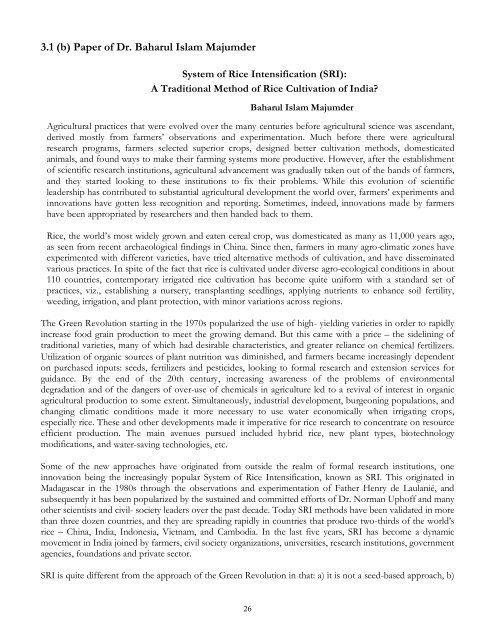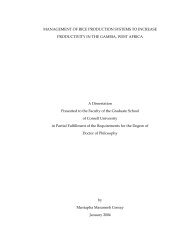Revised proceedings - The System of Rice Intensification - Cornell ...
Revised proceedings - The System of Rice Intensification - Cornell ...
Revised proceedings - The System of Rice Intensification - Cornell ...
Create successful ePaper yourself
Turn your PDF publications into a flip-book with our unique Google optimized e-Paper software.
3.1 (b) Paper <strong>of</strong> Dr. Baharul Islam Majumder<br />
<strong>System</strong> <strong>of</strong> <strong>Rice</strong> <strong>Intensification</strong> (SRI):<br />
A Traditional Method <strong>of</strong> <strong>Rice</strong> Cultivation <strong>of</strong> India?<br />
26<br />
Baharul Islam Majumder<br />
Agricultural practices that were evolved over the many centuries before agricultural science was ascendant,<br />
derived mostly from farmers‟ observations and experimentation. Much before there were agricultural<br />
research programs, farmers selected superior crops, designed better cultivation methods, domesticated<br />
animals, and found ways to make their farming systems more productive. However, after the establishment<br />
<strong>of</strong> scientific research institutions, agricultural advancement was gradually taken out <strong>of</strong> the hands <strong>of</strong> farmers,<br />
and they started looking to these institutions to fix their problems. While this evolution <strong>of</strong> scientific<br />
leadership has contributed to substantial agricultural development the world over, farmers‟ experiments and<br />
innovations have gotten less recognition and reporting. Sometimes, indeed, innovations made by farmers<br />
have been appropriated by researchers and then handed back to them.<br />
<strong>Rice</strong>, the world‟s most widely grown and eaten cereal crop, was domesticated as many as 11,000 years ago,<br />
as seen from recent archaeological findings in China. Since then, farmers in many agro-climatic zones have<br />
experimented with different varieties, have tried alternative methods <strong>of</strong> cultivation, and have disseminated<br />
various practices. In spite <strong>of</strong> the fact that rice is cultivated under diverse agro-ecological conditions in about<br />
110 countries, contemporary irrigated rice cultivation has become quite uniform with a standard set <strong>of</strong><br />
practices, viz., establishing a nursery, transplanting seedlings, applying nutrients to enhance soil fertility,<br />
weeding, irrigation, and plant protection, with minor variations across regions.<br />
<strong>The</strong> Green Revolution starting in the 1970s popularized the use <strong>of</strong> high- yielding varieties in order to rapidly<br />
increase food grain production to meet the growing demand. But this came with a price – the sidelining <strong>of</strong><br />
traditional varieties, many <strong>of</strong> which had desirable characteristics, and greater reliance on chemical fertilizers.<br />
Utilization <strong>of</strong> organic sources <strong>of</strong> plant nutrition was diminished, and farmers became increasingly dependent<br />
on purchased inputs: seeds, fertilizers and pesticides, looking to formal research and extension services for<br />
guidance. By the end <strong>of</strong> the 20th century, increasing awareness <strong>of</strong> the problems <strong>of</strong> environmental<br />
degradation and <strong>of</strong> the dangers <strong>of</strong> over-use <strong>of</strong> chemicals in agriculture led to a revival <strong>of</strong> interest in organic<br />
agricultural production to some extent. Simultaneously, industrial development, burgeoning populations, and<br />
changing climatic conditions made it more necessary to use water economically when irrigating crops,<br />
especially rice. <strong>The</strong>se and other developments made it imperative for rice research to concentrate on resource<br />
efficient production. <strong>The</strong> main avenues pursued included hybrid rice, new plant types, biotechnology<br />
modifications, and water-saving technologies, etc.<br />
Some <strong>of</strong> the new approaches have originated from outside the realm <strong>of</strong> formal research institutions, one<br />
innovation being the increasingly popular <strong>System</strong> <strong>of</strong> <strong>Rice</strong> <strong>Intensification</strong>, known as SRI. This originated in<br />
Madagascar in the 1980s through the observations and experimentation <strong>of</strong> Father Henry de Laulanié, and<br />
subsequently it has been popularized by the sustained and committed efforts <strong>of</strong> Dr. Norman Uph<strong>of</strong>f and many<br />
other scientists and civil- society leaders over the past decade. Today SRI methods have been validated in more<br />
than three dozen countries, and they are spreading rapidly in countries that produce two-thirds <strong>of</strong> the world‟s<br />
rice – China, India, Indonesia, Vietnam, and Cambodia. In the last five years, SRI has become a dynamic<br />
movement in India joined by farmers, civil society organizations, universities, research institutions, government<br />
agencies, foundations and private sector.<br />
SRI is quite different from the approach <strong>of</strong> the Green Revolution in that: a) it is not a seed-based approach, b)

















